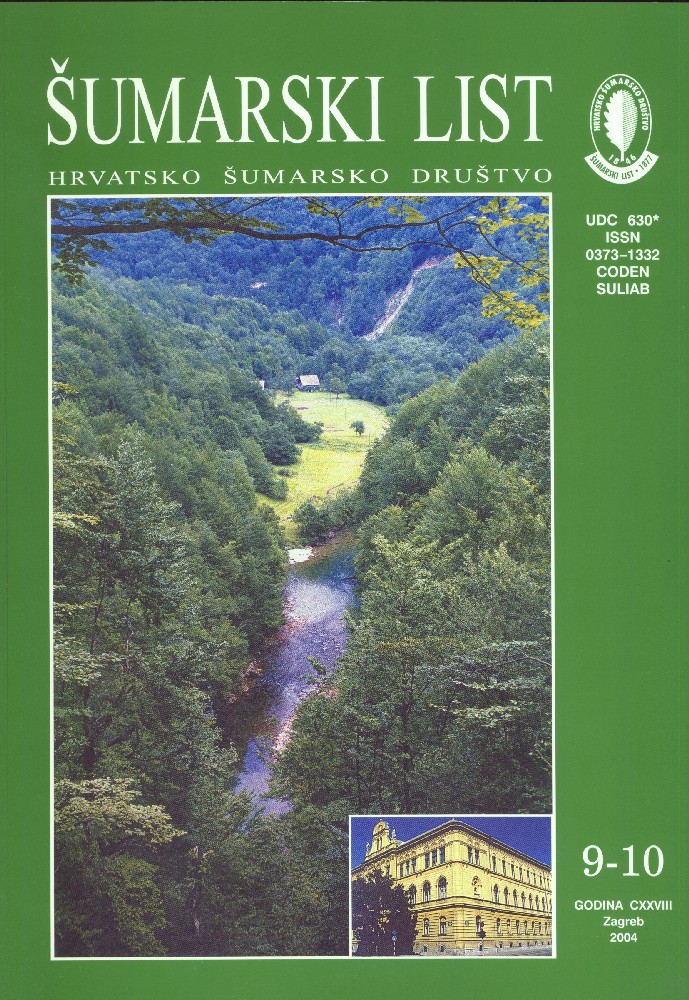| |
| IZVORNI ZNANSTVENI ČLANCI |
| |
|
|
| Krpan, A. P. B., Poršinsky, T., Stankić, I. | UDK 630* 363 (001) |
| Efficiency of Mechanical Felling and Processing in Soft and Hardwood broadleaved stands – Part 3: Efficiency of harvester in natural thinning stands of hardwood broadleaf species
pdf
HR
EN
|
495 |
| Kajba, D., Bogdan, S., Katičić-Trupčević, I. | UDK 630* 165 + 238 001. (Salix alba) |
| White Willow Biomass Production in a Short Rotation Clonal Test Dravica
pdf
HR
EN
|
509 |
Summary: A test with 14 white willow clones was conducted on the locality of Dravica (northeastern part of Croatia, near Osijek) following the randomized complete block system design with four replications. Clonal test was established by cuttings in March 1999, with 1.3 × 0.8 m spacing. The goal was to determine the potential of biomass production of selected clones in short rotations of 2 years, on the site not favorable for growing more valuable species of forest trees. At the age of 2/5 (2 years old shoots and 5 years old stump) diameter at breast height, survival and a number of shoots per stump was measured, and using the combination of the destructive and nondestructive methods, dry biomass of a single two year old shoots was assessed. The production of biomass per hectare was estimated with respect to the clones, mean dry biomass of shoots, survival, spacing, and the average number of shoots per stump.Average survival rate was 65.6 %, but there were significant differences between clones. The overall mean dry biomass production of all the investigated clones was 6.5 tons per hectare. The greatest production exhibited clones ‘B44’, ‘V093’ and ‘V052’ (10.2, 9.2 and 9.1 t/ha). Clones ‘B44’ and ‘V093’ showed specific adaptability to the investigated site and growth conditions through survival, above the average values of the total biomass production, as well as the greatest sprouting ability. Clones ‘V052’ and ‘V160’ showed good adaptability to tested site conditions through survival rate and sprouting ability, although their values of the mean dry biomass were average.For the purpose of greater productivity, after the first rotation, shoots should be reduced to one or two per stump. Research should be continued in the direction of identification and selection of a greater number of clones with specific adaptability to unfavorable sites, and the production of biomass on marginal sites could be significantly increased with the application of more intense growth and protection measures.
Key words: white willow clones; biomass; short rotation crops |
| Kremer, D. | UDK 630* 174 + 532 (001) |
| Morphometric Research of Leaves Characteristic of “American Ash” Acclimatized in Lowland Forests in Croatia
pdf
HR
EN
|
517 |
| Posavec, S., Žgela, T. | UDK 630* 232.3 + 765 (001) |
| Calculating the Prime Cost of Forest Seedlings of Pedunculate Oak (Quercus robur, L.)
pdf
HR
EN
|
529 |
| |
| PRETHODNO PRIOPĆENJE |
| |
|
|
| Šušnjar, M., Lukić, N. | UDK 630* 524 |
| Double-Entry Tables of Volume of Fir Trees from Forest Management Unit “Belevina”, Gorski Kotar
pdf
HR
EN
|
537 |
| |
| PREGLEDNI ČLANCI |
| |
|
|
| Pentek, T., Pičman, D., Nevečerel, H. | UDK 630* 684 |
| The Mean Wood Skidding Distance
pdf
HR
EN
|
545 |
| |
| PRETHODNO PRIOPĆENJE |
| |
|
|
| Frković, A. | UDK 630* 156 |
| Forester Jaroslav Šugh, Esq. and his “Posavski Lovac” (“The Hunter Of Posavina”)
pdf
HR
EN
|
559 |



